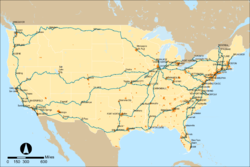National Rail Passenger Corporation

Geographic map of the Amtrak system ()
|
|
| Reporting mark | AMTK, AMTZ |
|---|---|
| Locale |
|
| Dates of operation | May 1, 1971–present |
| Predecessor | 20 privately operated intercity passenger rail systems |
| Track gauge | 4 ft 8 1⁄2 in (1,435 mm) standard gauge |
| Electrification |
|
| Length | 44 routes: 21,300 miles (34,000 km) Track owned: 730 miles (1,170 km) |
| Headquarters | Union Station, Washington, D.C. |
| Website | www |
The National Railroad Passenger Corporation, doing business as Amtrak /ˈæmtræk/, is a passenger railroad service that provides medium- and long-distance intercity service in the contiguous United States. Founded in 1971 to take over most of the remaining U.S. passenger rail services, it is partially government funded yet operated and managed as a for-profit corporation. Amtrak's headquarters is located in Union Station in Washington, D.C.
Amtrak serves more than 500 destinations in 46 states and three Canadian provinces, operating more than 300 trains each day over 21,300 miles (34,000 km) of track. Some track sections allow trains to run as fast as 150 mph (240 km/h).
In fiscal year 2016, Amtrak served 31.3 million passengers and had $2.192 billion in revenue, while employing more than 20,000 people. Nearly 85,700 passengers ride more than 300 Amtrak trains on a daily basis. Nearly two-thirds of passengers come from the 10 largest metropolitan areas; 83% of passengers travel on routes shorter than 400 miles (644 km).
The name "Amtrak" is a portmanteau of the words "America" and "trak", the latter itself a sensational spelling of "track".
In 1916, 98% of all commercial intercity travelers in the United States moved by rail, and the remaining 2% moved by inland waterways. Nearly 42 billion passengers used railways as primary transportation. Passenger trains were owned and operated by the same privately owned companies that operated freight trains. Thereafter patronage declined in the face of competition from buses, air travel, and the automobile. New streamlined diesel-powered trains such as the Pioneer Zephyr were popular with the traveling public but could not reverse the trend. By 1940 railroads held just 67 percent of commercial passenger-miles in the United States. In real terms, passenger-miles had fallen by 40% since 1916, from 42 billion to 25 billion.
...
Wikipedia
